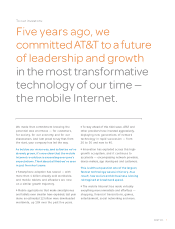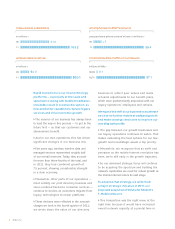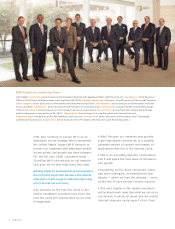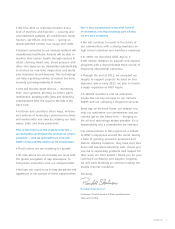AT&T Wireless 2011 Annual Report Download - page 7
Download and view the complete annual report
Please find page 7 of the 2011 AT&T Wireless annual report below. You can navigate through the pages in the report by either clicking on the pages listed below, or by using the keyword search tool below to find specific information within the annual report.AT&T Inc. 5
our industry’s development — as the mobile
Internet continues to disrupt yesterday’s
technologies and business models.
Our two companies’ compatible network
technologies and spectrum holdings made this
a unique opportunity — one that would have
allowed us to greatly expand our nationwide
deployment of the most advanced 4G LTE
network technology to more small towns and
rural communities.
In the end, we weren’t successful; the
transaction was opposed by the Federal
Communications Commission and the
Department of Justice, resulting in breakup
payments reflected in the $4 billion charge
we took in the fourth quarter.
But the transaction served to dramatize the
No. 1 forward-looking issue for our industry —
making enough spectrum available to keep up
with customer demand and enable the mobile
Internet revolution to reach its full potential.
Customer demand for the mobile Internet
continues to rise.
Over the next five years, on top of the
20,000 percent growth we’ve experienced since
2006, we conservatively expect our mobile
data traffic to grow more than 8X from today’s
levels — as more powerful networks connected
to the cloud take hold and supercharge the next
phase of the mobile revolution.
This means spectrum availability is crucial for
our customers, and it’s the critical public policy
issue for our industry.
That’s why we will continue to provide
leadership on this issue and advocate for equal
opportunities to acquire spectrum as soon as
possible, both on the open market and through
open auctions.
Meanwhile, we’re not waiting around. We
are leading the way on a number of fronts
to help increase network capacity and mobile
broadband accessibility while we continue
to pursue additional spectrum.
We’ve executed a number of smaller
spectrum transactions.
We’ve worked aggressively to add cell sites
and make the most of existing spectrum.
We’ve taken the initiative to help manage
existing capacity responsibly through usage-
based mobile data pricing and by managing
the speeds of the highest-volume unlimited
users. We want to ensure a better overall
experience for all of our users.
Now, we’re accelerating deployment of 4G LTE
technology. In addition to providing stunning
speeds, this most advanced network technology
provides a lift in network efficiency of roughly 30
to 40 percent over our current technology. But
as impressive as this capacity lift is, with current
rates of traffic growth, it’s only a near-term help.
As dramatic as the first five years in
the mobile broadband revolution have
been, the next five years will surpass
them by an order of magnitude …




















